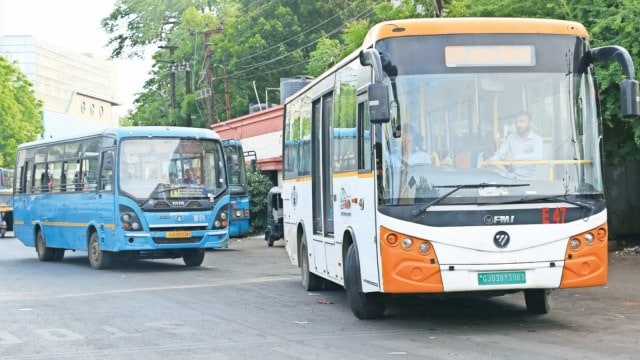Click here to join Express Pune WhatsApp channel and get a curated list of our stories
Pune has only half the buses it needs: ITDP study
According to the Tom Tom traffic index, Pune is the fourth worst city in the world in terms of average travel time per 10 km with it taking 33 minutes 22 seconds to cover the distance.
 Vasai Virar performs the worst with just 8 buses per lakh population. (Express File Photo)
Vasai Virar performs the worst with just 8 buses per lakh population. (Express File Photo)A recent analysis by the Institute for Transportation and Development Policy (ITDP) has highlighted the severe shortage of buses in many cities in Maharashtra, including Pune. “Pune and Pimpri Chinchwad operate a fleet of 2,200 buses but need to double the fleet to 4,500 to meet the demand,” said a press release by the group.
Vaishali Singh, programme manager, Transport Systems and Electric Mobility, at ITDP India said that Pune and Pimpri Chinchwad have a total of 2,200 buses at 29 buses per lakh population. But to meet the Ministry of Housing and Urban Affairs standard of 60 buses per lakh population, this number of buses will have to double.
Recommendations of the working group on urban transport for 12th Five Year Plan of the government of India (2012–17) also considered an assumption of requirement of 50 buses per lakh population for cities with a population greater than four million.
Transport issues in Pune
According to the Tom Tom traffic index, Pune is the fourth worst city in the world in terms of average travel time per 10 km with it taking 33 minutes 22 seconds to cover the distance. This problem is made worse by the dilapidated bus system of the city managed by the Pune Mahanagar Parivahan Mahamandal Ltd (PMPML). Major bus stops like Swargate and Deccan see a huge crowd of people, especially at peak hours.
Over the past few years, the number of buses in the city has come down. According to the PMPML’s statistical reports, the total (PMPML + buses on hire) buses per day in October in the past four years are 1,947 buses in 2024; 2,119 buses in 2023; 2,121 buses in 2022 and 2,092 buses in 2021.
Urban transport planner Bhaumik Gowande said that for the bus fleet numbers to increase, cities have to make sure that they are not just buying new buses but also replacing buses that retire. This means the procurement has to be in even greater numbers. “Nearly 50 buses per 1 lakh population is a very well-known fact in Maharashtra. Multiple presentations (to governments) have happened regarding this. But there is no response,” said Gowande and added, “The main problem is there is no supply of buses and there is a slow supply of buses.”
If a sufficient number of buses are procured and bus routes rationalised, Gowande opines that PMPML ridership can see a minimum increase of 30%. According to the PMPML website, the current daily ridership is just over 10 lakh passengers.
Situation in other cities in Maharashtra
The data shared by ITDP shows that none of the top eight cities in Maharashtra meet the optimum number of 40-60 buses per lakh population. Vasai Virar performs the worst with just 8 buses per lakh population.
Shortage of buses
| City | Current Buses | Buses per lakh population | Buses required |
| Greater Mumbai | 3600 | 27 | 7899 |
| Nagpur | 627 | 21 | 1470 |
| Thane | 650 | 22 | 1468 |
| Vasai Vihar | 220 | 8 | 1304 |
| Navi Mumbai | 567 | 27 | 1032 |
| Nashik | 250 | 13 | 1000 |
| Kalyan Dombivali | 208 | 11 | 952 |
Click here to join Express Pune WhatsApp channel and get a curated list of our stories








